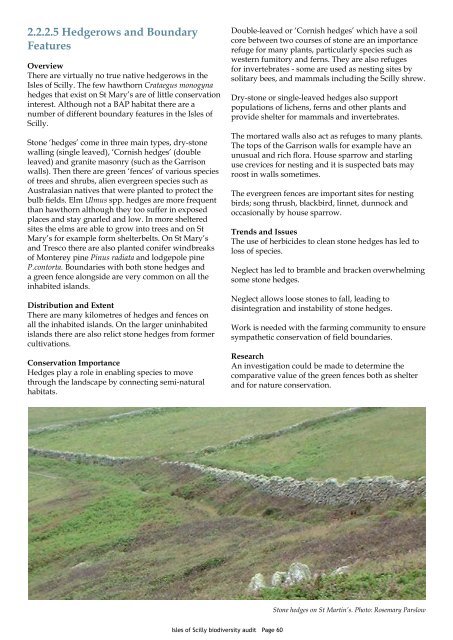The Isles of Scilly Biodiversity Audit 2008 - Cornwall Wildlife Trust
The Isles of Scilly Biodiversity Audit 2008 - Cornwall Wildlife Trust
The Isles of Scilly Biodiversity Audit 2008 - Cornwall Wildlife Trust
Create successful ePaper yourself
Turn your PDF publications into a flip-book with our unique Google optimized e-Paper software.
2.2.2.5 Hedgerows and BoundaryFeaturesOverview<strong>The</strong>re are virtually no true native hedgerows in the<strong>Isles</strong> <strong>of</strong> <strong>Scilly</strong>. <strong>The</strong> few hawthorn Crataegus monogynahedges that exist on St Mary’s are <strong>of</strong> little conservationinterest. Although not a BAP habitat there are anumber <strong>of</strong> different boundary features in the <strong>Isles</strong> <strong>of</strong><strong>Scilly</strong>.Stone ‘hedges’ come in three main types, dry-stonewalling (single leaved), ‘Cornish hedges’ (doubleleaved) and granite masonry (such as the Garrisonwalls). <strong>The</strong>n there are green ‘fences’ <strong>of</strong> various species<strong>of</strong> trees and shrubs, alien evergreen species such asAustralasian natives that were planted to protect thebulb fields. Elm Ulmus spp. hedges are more frequentthan hawthorn although they too suffer in exposedplaces and stay gnarled and low. In more shelteredsites the elms are able to grow into trees and on StMary’s for example form shelterbelts. On St Mary’sand Tresco there are also planted conifer windbreaks<strong>of</strong> Monterey pine Pinus radiata and lodgepole pineP.contorta. Boundaries with both stone hedges anda green fence alongside are very common on all theinhabited islands.Distribution and Extent<strong>The</strong>re are many kilometres <strong>of</strong> hedges and fences onall the inhabited islands. On the larger uninhabitedislands there are also relict stone hedges from formercultivations.Conservation ImportanceHedges play a role in enabling species to movethrough the landscape by connecting semi-naturalhabitats.Double-leaved or ‘Cornish hedges’ which have a soilcore between two courses <strong>of</strong> stone are an importancerefuge for many plants, particularly species such aswestern fumitory and ferns. <strong>The</strong>y are also refugesfor invertebrates - some are used as nesting sites bysolitary bees, and mammals including the <strong>Scilly</strong> shrew.Dry-stone or single-leaved hedges also supportpopulations <strong>of</strong> lichens, ferns and other plants andprovide shelter for mammals and invertebrates.<strong>The</strong> mortared walls also act as refuges to many plants.<strong>The</strong> tops <strong>of</strong> the Garrison walls for example have anunusual and rich flora. House sparrow and starlinguse crevices for nesting and it is suspected bats mayroost in walls sometimes.<strong>The</strong> evergreen fences are important sites for nestingbirds; song thrush, blackbird, linnet, dunnock andoccasionally by house sparrow.Trends and Issues<strong>The</strong> use <strong>of</strong> herbicides to clean stone hedges has led toloss <strong>of</strong> species.Neglect has led to bramble and bracken overwhelmingsome stone hedges.Neglect allows loose stones to fall, leading todisintegration and instability <strong>of</strong> stone hedges.Work is needed with the farming community to ensuresympathetic conservation <strong>of</strong> field boundaries.ResearchAn investigation could be made to determine thecomparative value <strong>of</strong> the green fences both as shelterand for nature conservation.Stone hedges on St Martin’s. Photo: Rosemary Parslow<strong>Isles</strong> <strong>of</strong> <strong>Scilly</strong> biodiversity audit Page 60
















